Global Hydrogen Valve Market By Valve Type, By Material, By Function, By End Use Industry, By Region & Segmental Insights Trends and Forecast, 2024 – 2034
- Industry: Semiconductors & Electronics
- Report ID: TNR-110-1262
- Number of Pages: 420
- Table/Charts : Yes
- August, 2024
- Base Year : 2024
- No. of Companies : 10+
- No. of Countries : 29
- Views : 10052
- Covid Impact Covered: Yes
- War Impact Covered: Yes
- Formats : PDF, Excel, PPT
A hydrogen valve controls the flow and pressure of hydrogen gas in systems, ensuring safe and efficient operation. It’s crucial in applications like fuel cells, energy storage, and industrial processes. The global hydrogen valve market is experiencing substantial growth, driven by the increasing adoption of hydrogen fuel cells and advancements in hydrogen infrastructure. Valves are critical for managing hydrogen flow and pressure across various applications, including automotive, energy, and industrial sectors. The market’s expansion is fueled by rising investments in green energy and stringent environmental regulations promoting cleaner fuel alternatives.
According to recent statistics, the global hydrogen valve market was valued at approximately USD 268.5 Mn in 2024 projected to reach USD 648.3 Mn by 2034; expected to grow at a CAGR of 8.3% from 2024 to 2034. Innovations in valve technology, such as enhanced materials for high-pressure and cryogenic conditions, are further accelerating market growth. Key regions driving this trend include North America, Europe, and Asia-Pacific, with significant contributions from emerging markets in Latin America and the Middle East. As hydrogen technology evolves, the demand for specialized, high-performance valves is expected to increase, shaping the market’s future trajectory.
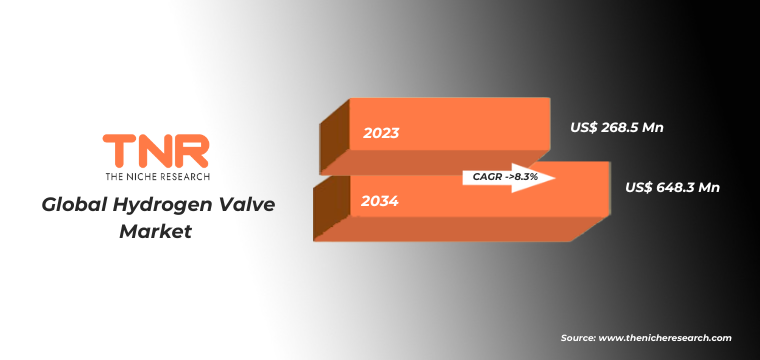
Global Hydrogen Valve Market Dynamics
Global Hydrogen Valve Market Growth Driver:
- Rise in Hydrogen Fuel Cell Adoption: The growing adoption of hydrogen fuel cells in automotive and energy sectors is a major growth driver. Fuel cells require reliable hydrogen valves to manage high-pressure and cryogenic conditions, boosting demand for advanced valve technologies and supporting market expansion.
- Investment in Hydrogen Infrastructure: Increasing investments in hydrogen infrastructure, including production, storage, and distribution facilities, are driving market growth. Enhanced infrastructure development necessitates advanced hydrogen valves for efficient and safe operation, thereby propelling demand and fostering innovation within the hydrogen valve sector.
Global Hydrogen Valve Market Restraint:
- High Production Costs: The high cost of manufacturing specialized hydrogen valves, due to advanced materials and technology requirements, poses a significant challenge. This can limit affordability and slow down adoption, particularly in cost-sensitive sectors and emerging markets.
- Regulatory and Safety Standards: Strict regulatory and safety standards for handling hydrogen, due to its flammability and high pressure, create complexities in valve design and certification. Meeting these rigorous requirements can delay product development and increase compliance costs, impacting market growth.
Global Hydrogen Valve Market Opportunity:
- Technological Advancements: Innovations in valve materials and design, such as enhanced corrosion resistance and high-pressure capabilities, present significant opportunities. These advancements can lead to the development of more efficient and reliable hydrogen valves, expanding their application in fuel cells and energy storage systems.
- Expansion into Emerging Markets: As hydrogen infrastructure develops in emerging markets, there is a growing opportunity for valve manufacturers to establish a presence. Expanding into regions with increasing investments in hydrogen energy can drive demand and open new revenue streams for advanced hydrogen valve solutions.
Global Hydrogen Valve Market Trends:
- Integration with Smart Technologies: The integration of smart technologies, such as IoT and advanced sensors, is becoming a prominent trend. These innovations enable real-time monitoring and control of hydrogen systems, enhancing valve performance and safety while providing valuable data for maintenance and operational efficiency.
- Focus on Sustainability: There is a growing emphasis on developing eco-friendly and sustainable hydrogen valves. Manufacturers are increasingly prioritizing the use of recyclable materials and energy-efficient production processes, aligning with global sustainability goals and responding to market demand for greener technology solutions.
Global Hydrogen Valve Market Segmental Analysis:
Global Hydrogen Valve Market By Valve Type
The gate valves segment has quickly emerged as the fastest-growing area in the global hydrogen valve market, driven by their superior performance in high-pressure and high-flow applications. Gate valves are favored for their minimal pressure drop and efficient flow control, which is essential for managing hydrogen in various systems. Their robust design allows for reliable operation under extreme conditions, making them highly suitable for hydrogen production, storage, and distribution. Compared to other valve types, gate valves offer better sealing capabilities and reduced turbulence, contributing to their increased adoption. As hydrogen infrastructure expands, the demand for gate valves is expected to rise significantly, outpacing other valve segments.
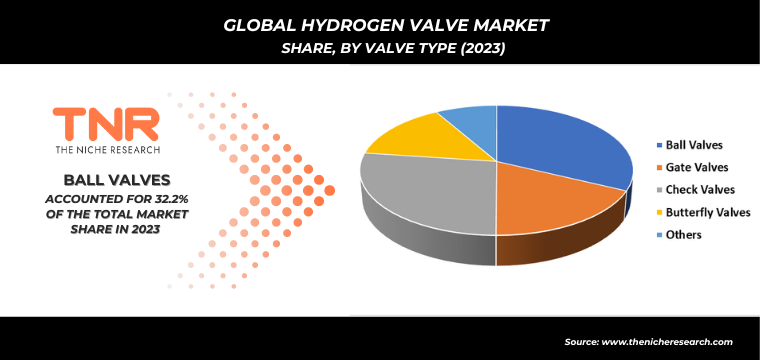
Global Hydrogen Valve Market By Material
In 2023, the stainless-steel segment led the global hydrogen valve market, securing a significant revenue share of 38.3%. Stainless steel’s superior performance in the hydrogen sector stems from its excellent corrosion resistance, durability, and ability to withstand high pressures and temperatures. These properties make it ideal for managing hydrogen, which is both highly reactive and requires robust containment. Compared to other materials, stainless steel provides reliable, long-term performance and lower maintenance costs, driving its preference in critical hydrogen applications such as storage and distribution systems.
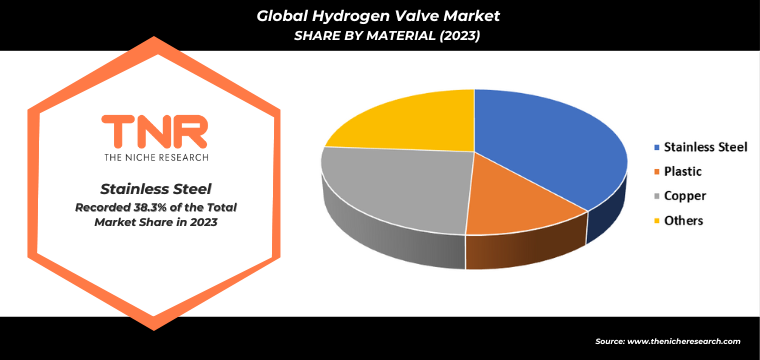
Global Hydrogen Valve Market By Function
The automatic valves segment led the global hydrogen valve market, capturing a revenue share of 61.4%, driven by their superior functionality and efficiency. Automatic valves, including solenoid and control valves, are preferred over manual valves for their ability to operate seamlessly without human intervention. They offer precise control and rapid response to changing conditions, which is crucial for maintaining safe and efficient hydrogen systems. Automatic valves are integral in applications requiring real-time adjustments and remote operation, such as in hydrogen production and distribution. Their ability to enhance operational efficiency and safety contributes significantly to their dominant market position.
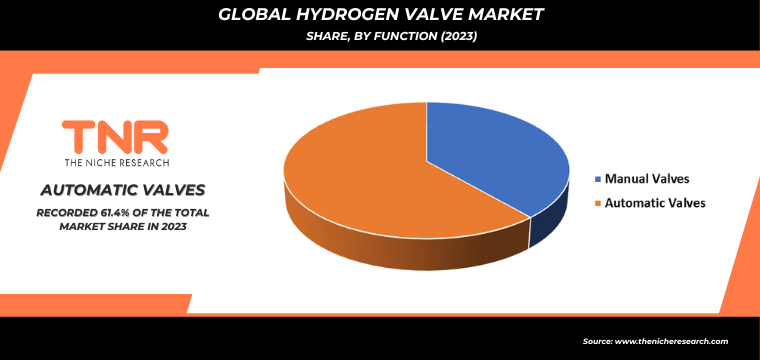
Global Hydrogen Valve Market By End Use Industry
By end-use industry, the automotive segment is expected to experience the fastest growth in the global hydrogen valve market over the forecast period, due to the rising adoption of hydrogen fuel cell vehicles. These vehicles require advanced hydrogen valves to manage fuel delivery and optimize engine performance. As governments and automakers invest heavily in hydrogen technology to meet environmental regulations and reduce carbon emissions, the demand for high-performance hydrogen valves in the automotive sector is surging. The automotive industry’s push toward cleaner energy solutions, coupled with advancements in fuel cell technology, is significantly accelerating the need for reliable and efficient hydrogen valves in this segment.
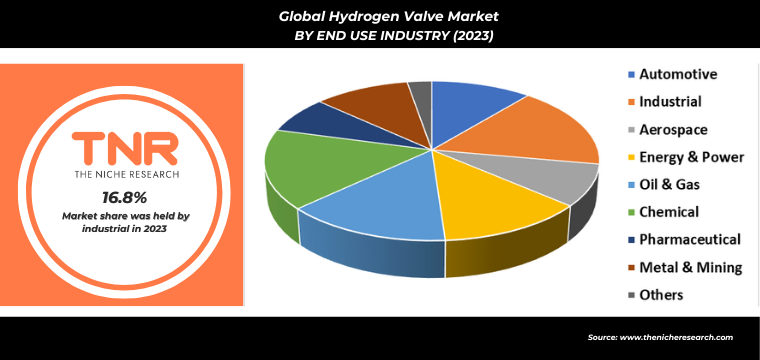
Global Hydrogen Valve Market By Region
The regional dominance was held by Asia Pacific region in the global hydrogen valve market owing to its rapid advancements in hydrogen infrastructure and increasing investments in clean energy technologies. Countries like Japan, South Korea, and China are leading the charge in hydrogen fuel cell development and industrial applications, driving high demand for advanced hydrogen valves. Additionally, supportive government policies and growing automotive markets in the region further contribute to its dominance. The robust growth of hydrogen technology and infrastructure in Asia-Pacific is significantly propelling the regional market share.
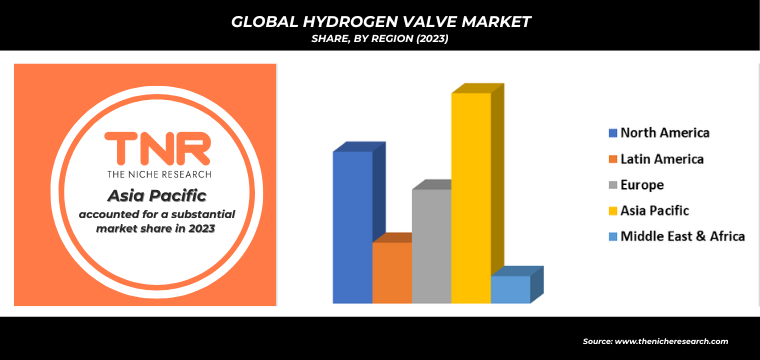
Competitive Landscape
The competitive landscape of the global hydrogen valve market is characterized by intense competition among key players, driven by innovation, technological advancements, and strategic partnerships to capture market share.
Some of the players operating in the hydrogen valve market are
- AIRAFlow Inc.
- Auma Riester GmbH & Co. KG
- Burkert Fluid Control Systems
- Emerson Electric Co.
- Flowserve Corporation
- Honeywell International Inc.
- HOVAL Valve Company
- ITT Inc.
- Kitz Corporation
- KSB SE & Co. KGaA
- Orbinox S.L.
- Parker Hannifin Corporation
- Samgong Valve Co., Ltd.
- Swagelok Company
- Valmet Corporation
- Other Industry Participants
Key Developments:
- In November 2023, Parker Hannifin Corp’s Instrumentation Product Division introduced the Hi-Pro series valve and HNV series needle valve, featuring fully integrated O-LOK O-Ring Face Seal (ORFS) fitting connections. This expansion strengthens the company’s successful lineup, which already includes A-LOK two-ferrule connections.
Global Hydrogen Valve Market Scope:
| Report Specifications | Details |
| Market Revenue in 2023 | US$ 268.5 Mn |
| Market Size Forecast by 2034 | US$ 648.3 Mn |
| Growth Rate (CAGR) | 8.3% |
| Historic Data | 2016 – 2022 |
| Base Year for Estimation | 2023 |
| Forecast Period | 2024 – 2034 |
| Report Inclusions | Market Size & Estimates, Market Dynamics, Competitive Scenario, Trends, Growth Factors, Market Determinants, Key Investment Segmentation, Product/Service/Solutions Benchmarking |
| Segments Covered | By Valve Type, By Material, By Function, By End Use Industry, By Region |
| Regions Covered | North America, Europe, Asia Pacific, Middle East & Africa, Latin America |
| Countries Covered | U.S., Canada, Mexico, Rest of North America, France, The UK, Spain, Germany, Italy, Nordic Countries (Denmark, Finland, Iceland, Sweden, Norway), Benelux Union (Belgium, The Netherlands, Luxembourg), Rest of Europe, China, Japan, India, New Zealand, Australia, South Korea, Southeast Asia (Indonesia, Thailand, Malaysia, Singapore, Rest of Southeast Asia), Rest of Asia Pacific, Saudi Arabia, UAE, Egypt, Kuwait, South Africa, Rest of Middle East & Africa, Brazil, Argentina, Rest of Latin America |
| Key Players | AIRAFlow Inc., Auma Riester GmbH & Co. KG, Burkert Fluid Control Systems, Emerson Electric Co., Flowserve Corporation, Honeywell International Inc., HOVAL Valve Company, ITT Inc., Kitz Corporation, KSB SE & Co. KGaA, Orbinox S.L., Parker Hannifin Corporation, Samgong Valve Co., Ltd., Swagelok Company, Valmet Corporation |
| Customization Scope | Customization allows for the inclusion/modification of content pertaining to geographical regions, countries, and specific market segments. |
| Pricing & Procurement Options | Explore purchase options tailored to your specific research requirements |
| Contact Details | Consult With Our Expert
Japan (Toll-Free): +81 663-386-8111 South Korea (Toll-Free): +82-808- 703-126 Saudi Arabia (Toll-Free): +966 800-850-1643 United Kingdom: +44 753-710-5080 United States: +1 302-232-5106 E-mail: askanexpert@thenicheresearch.com
|
Global Hydrogen Valve Market Segmentation:
By Valve Type
- Ball Valves
- Gate Valves
- Check Valves
- Butterfly Valves
- Others
By Material
- Stainless Steel
- Plastic
- Copper
- Others
By Function
- Manual Valves
- Automatic Valves
By End Use Industry
- Automotive
- Industrial
- Aerospace
- Energy & Power
- Oil & Gas
- Chemical
- Pharmaceutical
- Metal & Mining
- Others
By Region
- North America (U.S., Canada, Mexico, Rest of North America)
- Europe (France, The UK, Spain, Germany, Italy, Nordic Countries (Denmark, Finland, Iceland, Sweden, Norway), Benelux Union (Belgium, The Netherlands, Luxembourg), Rest of Europe)
- Asia Pacific (China, Japan, India, New Zealand, Australia, South Korea, Southeast Asia (Indonesia, Thailand, Malaysia, Singapore, Rest of Southeast Asia), Rest of Asia Pacific)
- Middle East & Africa (Saudi Arabia, UAE, Egypt, Kuwait, South Africa, Rest of Middle East & Africa)
- Latin America (Brazil, Argentina, Rest of Latin America)
Report Layout:
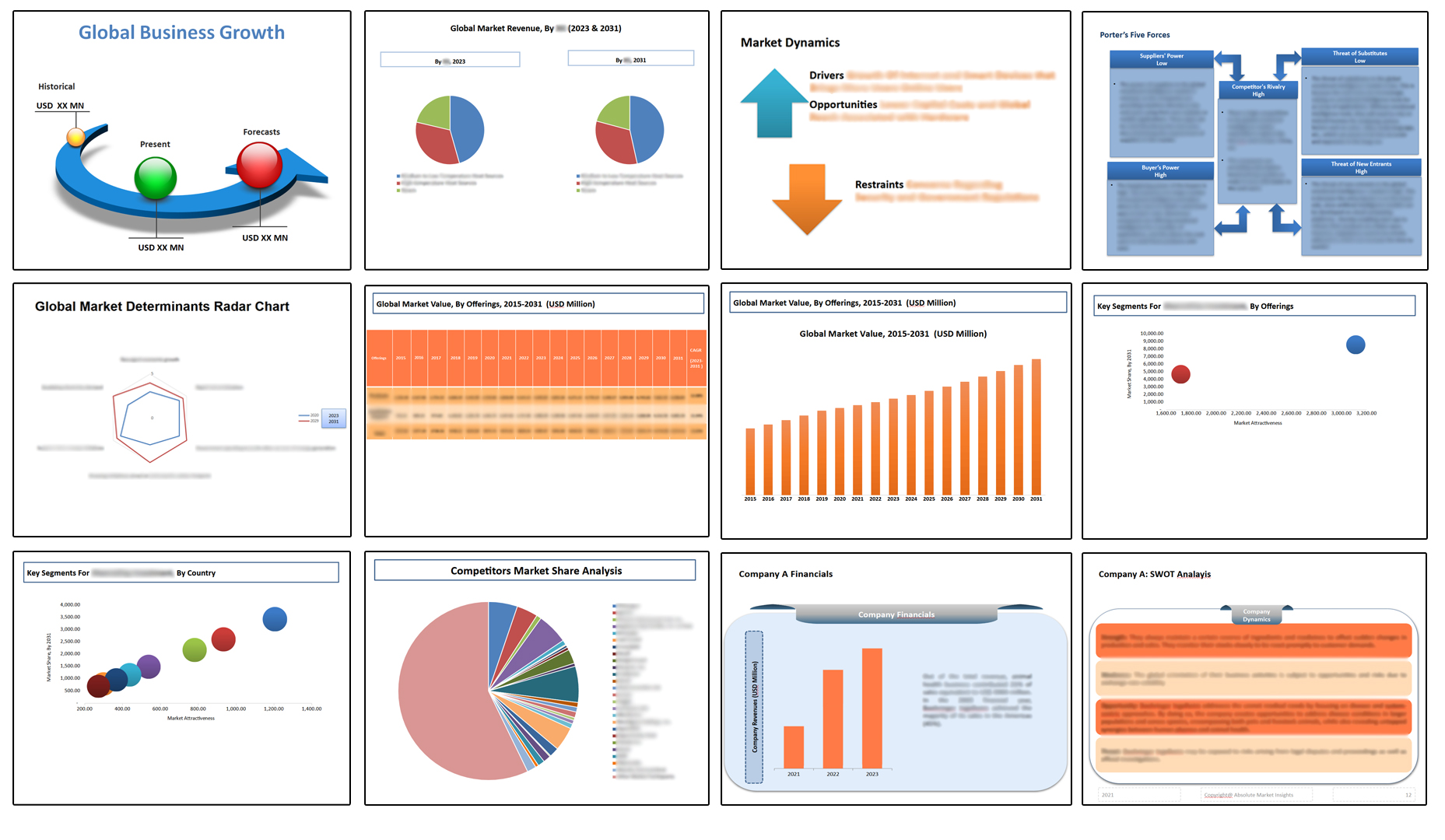
Table of Contents
Note: This ToC is tentative and can be changed according to the research study conducted during the course of report completion.
**Exclusive for Multi-User and Enterprise User.
Global Hydrogen Valve Market Segmentation:
By Valve Type
- Ball Valves
- Gate Valves
- Check Valves
- Butterfly Valves
- Others
By Material
- Stainless Steel
- Plastic
- Copper
- Others
By Function
- Manual Valves
- Automatic Valves
By End Use Industry
- Automotive
- Industrial
- Aerospace
- Energy & Power
- Oil & Gas
- Chemical
- Pharmaceutical
- Metal & Mining
- Others
By Region
- North America (U.S., Canada, Mexico, Rest of North America)
- Europe (France, The UK, Spain, Germany, Italy, Nordic Countries (Denmark, Finland, Iceland, Sweden, Norway), Benelux Union (Belgium, The Netherlands, Luxembourg), Rest of Europe)
- Asia Pacific (China, Japan, India, New Zealand, Australia, South Korea, Southeast Asia (Indonesia, Thailand, Malaysia, Singapore, Rest of Southeast Asia), Rest of Asia Pacific)
- Middle East & Africa (Saudi Arabia, UAE, Egypt, Kuwait, South Africa, Rest of Middle East & Africa)
- Latin America (Brazil, Argentina, Rest of Latin America)
The Niche Research approach encompasses both primary and secondary research methods to provide comprehensive insights. While primary research is the cornerstone of our studies, we also incorporate secondary research sources such as company annual reports, premium industry databases, press releases, industry journals, and white papers.
Within our primary research, we actively engage with various industry stakeholders, conducting paid interviews and surveys. Our meticulous analysis extends to every market participant in major countries, allowing us to thoroughly examine their portfolios, calculate market shares, and segment revenues.
Our data collection primarily focuses on individual countries within our research scope, enabling us to estimate regional market sizes. Typically, we employ a bottom-up approach, meticulously tracking trends in different countries. We analyze growth drivers, constraints, technological innovations, and opportunities for each country, ultimately arriving at regional figures.Our process begins by examining the growth prospects of each country. Building upon these insights, we project growth and trends for the entire region. Finally, we utilize our proprietary model to refine estimations and forecasts.
Our data validation standards are integral to ensuring the reliability and accuracy of our research findings. Here’s a breakdown of our data validation processes and the stakeholders we engage with during our primary research:
- Supply Side Analysis: We initiate a supply side analysis by directly contacting market participants, through telephonic interviews and questionnaires containing both open-ended and close-ended questions. We gather information on their portfolios, segment revenues, developments, and growth strategies.
- Demand Side Analysis: To gain insights into adoption trends and consumer preferences, we reach out to target customers and users (non-vendors). This information forms a vital part of the qualitative analysis section of our reports, covering market dynamics, adoption trends, consumer behavior, spending patterns, and other related aspects.
- Consultant Insights: We tap into the expertise of our partner consultants from around the world to obtain their unique viewpoints and perspectives. Their insights contribute to a well-rounded understanding of the markets under investigation.
- In-House Validation: To ensure data accuracy and reliability, we conduct cross-validation of data points and information through our in-house team of consultants and utilize advanced data modeling tools for thorough verification.
The forecasts we provide are based on a comprehensive assessment of various factors, including:
- Market Trends and Past Performance (Last Five Years): We accurately analyze market trends and performance data from preceding five years to identify historical patterns and understand the market’s evolution.
- Historical Performance and Growth of Market Participants: We assess the historical performance and growth trajectories of key market participants. This analysis provides insights into the competitive landscape and individual company strategies.
- Market Determinants Impact Analysis (Next Eight Years): We conduct a rigorous analysis of the factors that are projected to influence the market over the next eight years. This includes assessing both internal and external determinants that can shape market dynamics.
- Drivers and Challenges for the Forecast Period:Identify the factors expected to drive market growth during the forecast period, as well as the challenges that the industry may face. This analysis aids in deriving an accurate growth rate projection.
- New Acquisitions, Collaborations, or Partnerships: We keep a close watch on any new acquisitions, collaborations, or partnerships within the industry. These developments can have a significant impact on market dynamics and competitiveness.
- Macro and Micro Factors Analysis:A thorough examination of both macro-level factors (e.g., economic trends, regulatory changes) and micro-level factors (e.g., technological advancements, consumer preferences) that may influence the market during the forecast period.
- End-User Sentiment Analysis: To understand the market from the end-user perspective, we conduct sentiment analysis. This involves assessing the sentiment, preferences, and feedback of the end-users, which can provide valuable insights into market trends.
- Perspective of Primary Participants: Insights gathered directly from primary research participants play a crucial role in shaping our forecasts. Their perspectives and experiences provide valuable qualitative data.
- Year-on-Year Growth Trend: We utilize a year-on-year growth trend based on historical market growth and expected future trends. This helps in formulating our growth projections, aligning them with the market’s historical performance.
Research process adopted by TNR involves multiple stages, including data collection, validation, quality checks, and presentation. It’s crucial that the data and information we provide add value to your existing market understanding and expertise. We have also established partnerships with business consulting, research, and survey organizations across regions and globally to collaborate on regional analysis and data validation, ensuring the highest level of accuracy and reliability in our reports.








